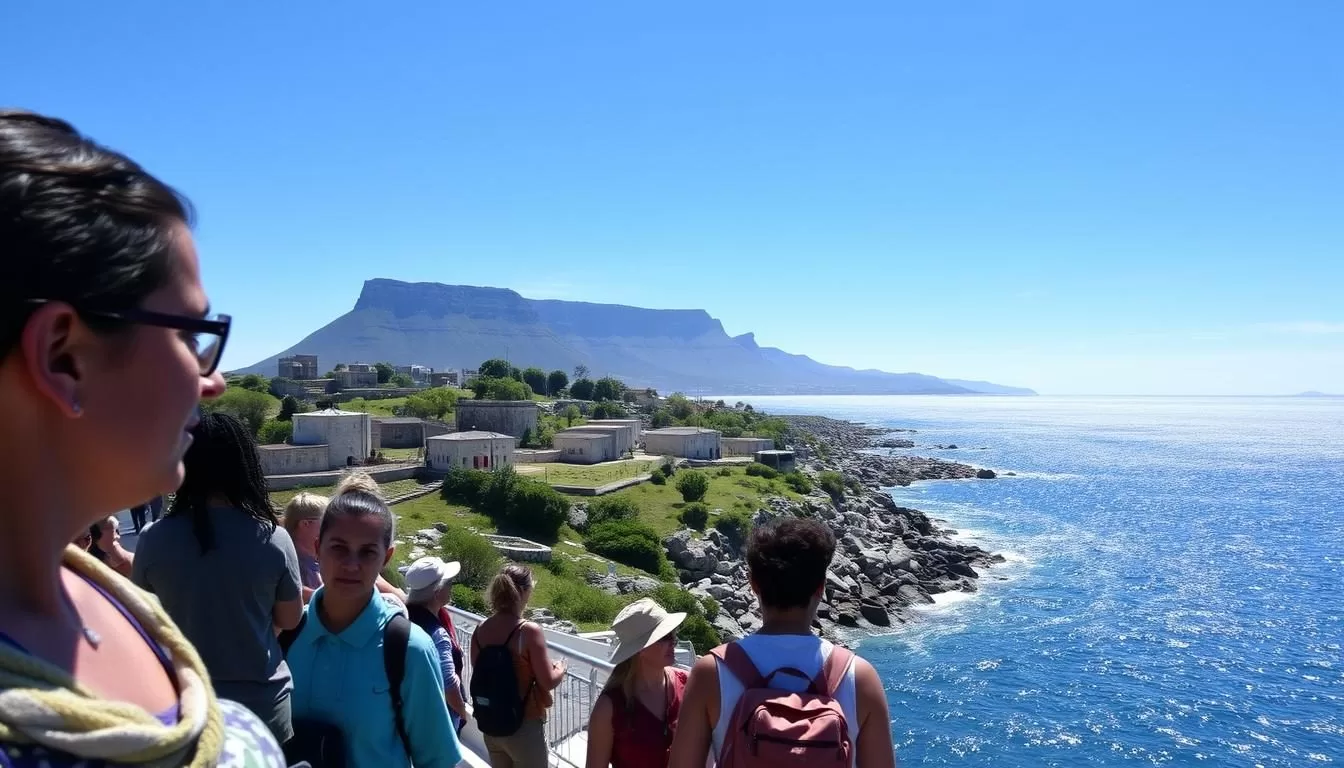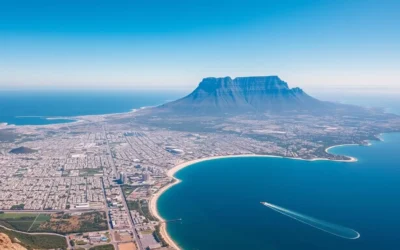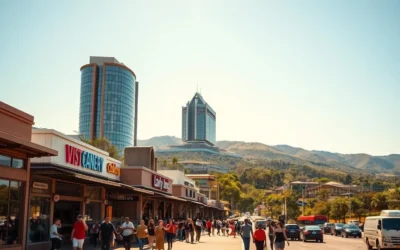✓ Accommodations✓ Flights✓ Rental Cars
Located just off the coast of Cape Town, Robben Island is a significant historical site that offers a powerful glimpse into South Africa’s complex past and journey toward democracy.
As a former prison where Nelson Mandela spent 18 of his 27 years of incarceration, the island has transformed from a place of oppression to a symbol of triumph over adversity.
Your visit to Robben Island combines stunning views of Cape Town and Table Mountain with deeply moving historical experiences. This comprehensive guide will walk you through everything you need to know about visiting Robben Island, from booking your tour to understanding what you’ll see and experience during your visit.
The Historical Significance of Robben Island
With a history spanning over 500 years, Robben Island has played a pivotal role in South Africa’s past. The island’s role has evolved dramatically, from being a place of banishment for the indigenous Khoi-Khoi people to its most notable period as a maximum-security prison during South Africa’s apartheid era.
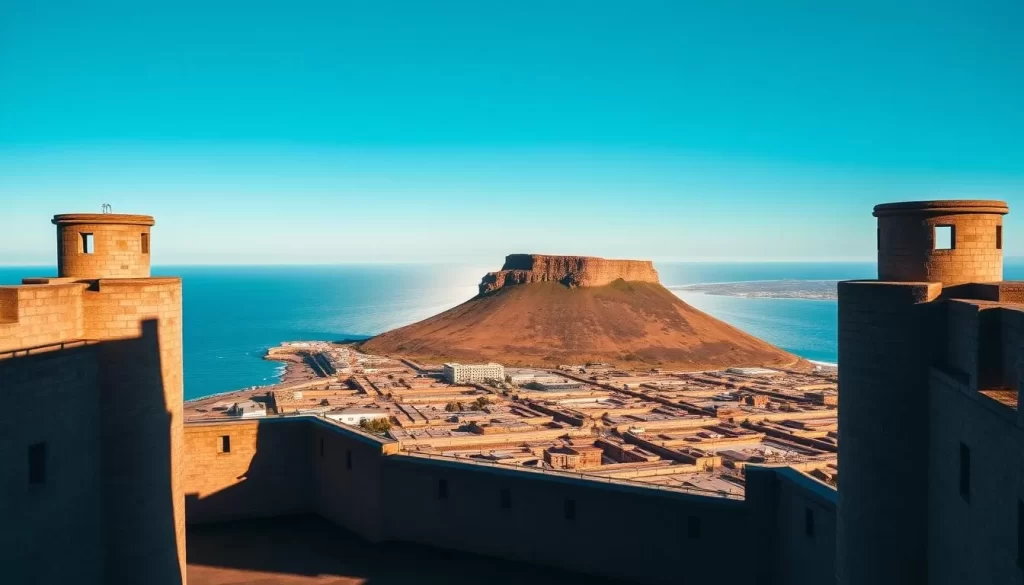
From Leper Colony to Political Prison
In the mid-1800s, Robben Island served as a leper colony, isolating those afflicted with the disease until most had passed away before a cure was discovered. This period marked a tragic chapter in the island’s long history. The island’s transformation into a political prison began during the apartheid years, when the South African government used it to isolate and break the spirit of those opposing the racist regime.
| Period | Use of Robben Island | Notable Events |
|---|---|---|
| 1400-1823 | Banishment of indigenous Khoi-Khoi people | First recorded South Africans on the island |
| Mid to late 1800s | Leper Colony | Lepers were isolated; most died before a cure was found |
| Apartheid Era | Maximum-security prison | Nelson Mandela and other political prisoners were held |
Nelson Mandela’s 18 Years on Robben Island
Nelson Mandela, who later became South Africa’s first democratically elected president, spent 18 of his 27 years of imprisonment on Robben Island. Mandela and other political prisoners endured harsh conditions designed to crush their resolve. Despite these conditions, Robben Island became a place of education and political development, with prisoners teaching each other and strengthening their commitment to creating a democratic South Africa.
The harsh realities of life on Robben Island, including the forced labor in the limestone quarry, became a testament to the prisoners’ resilience. Today, Robben Island stands as a powerful reminder of South Africa’s journey from apartheid to democracy, symbolizing both the cruelty and the triumph of the human spirit.
Planning Your Visit to Robben Island
Planning your visit to Robben Island in advance ensures a smooth and enriching experience. To make the most of your trip, it’s crucial to understand the logistics involved in visiting this historic site.
Robben Island Tours from Cape Town
The only way to visit Robben Island is through an official tour, which can be booked directly through the Robben Island Museum website or through reputable tour providers like GetYourGuide. Tours depart from Cape Town’s V&A Waterfront four times daily.

Tours are available at 9:00 AM, 11:00 AM, 1:00 PM, and 3:00 PM, giving you flexibility in planning your day. It’s advisable to book your tour in advance, especially during peak season.
Ticket Prices and Booking Information
Ticket prices vary depending on nationality. International adult visitors pay approximately R600 (about $32), while children pay R310 (about $17). South African citizens enjoy reduced rates, with adults paying R400 and children R210.
Booking in advance is recommended, especially during the busy summer season from November to March.
Best Time to Visit Robben Island
The best time to visit Robben Island is during the shoulder seasons of February-March and September-October, when the weather is pleasant and the crowds have thinned out. If you’re looking for sunshine, the summer months between November and March are ideal, but be prepared for larger crowds and higher prices.
Your entire Robben Island experience, including the ferry ride and guided tour, will take approximately 3.5-4 hours. Plan accordingly when scheduling the rest of your Cape Town activities.
Getting to Robben Island
Traveling to Robben Island is an adventure in itself, with a ferry ride that offers breathtaking views. The ferry service is the only way to reach the island, and it departs from the Nelson Mandela Gateway at the V&A Waterfront in Cape Town.
Ferry Departures from V&A Waterfront
Your journey to Robben Island begins at the Nelson Mandela Gateway, located in the heart of Cape Town’s V&A Waterfront. To ensure a smooth departure, it’s recommended that you arrive at least 15-20 minutes before your scheduled ferry time. This allows sufficient time for security checks and boarding procedures.
The V&A Waterfront is a bustling hub, and the ferry services to Robben Island operate from here, making it a convenient starting point for your visit.
What to Expect During the Ferry Ride
The ferry ride from Cape Town to Robben Island typically takes between 30-40 minutes each way, depending on the weather and sea conditions. During this time, you’ll be treated to spectacular views of Cape Town’s cityscape, Table Mountain, and the coastline. Keep your camera handy to capture these moments.
The ferry ride can be an adventure, especially on windy days when the waters become choppy. If you’re prone to seasickness, consider taking motion sickness medication before your trip. The ferries are modern and comfortable, with both indoor and outdoor seating areas available.
- Your journey begins at the Nelson Mandela Gateway.
- Arrive at least 15-20 minutes before departure.
- The ferry ride offers panoramic views of Cape Town.
- Ferries are modern and comfortable.
Robben Island, South Africa: Best Things to Do – Top Picks
As you step onto Robben Island, you’re not just visiting a place; you’re stepping into a piece of history. Robben Island, located off the coast of South Africa, is a significant historical site that offers a unique experience for visitors today. The island is renowned for its role during the apartheid era, particularly for being the prison where Nelson Mandela and other political prisoners were held.
Exploring the Maximum Security Prison
The highlight of any visit to Robben Island is exploring the maximum security prison where Nelson Mandela and other political prisoners were held during South Africa’s apartheid era. Walking through the prison corridors with a former political prisoner as your guide provides an unparalleled, authentic experience that brings the island’s history to life in a way no textbook could.
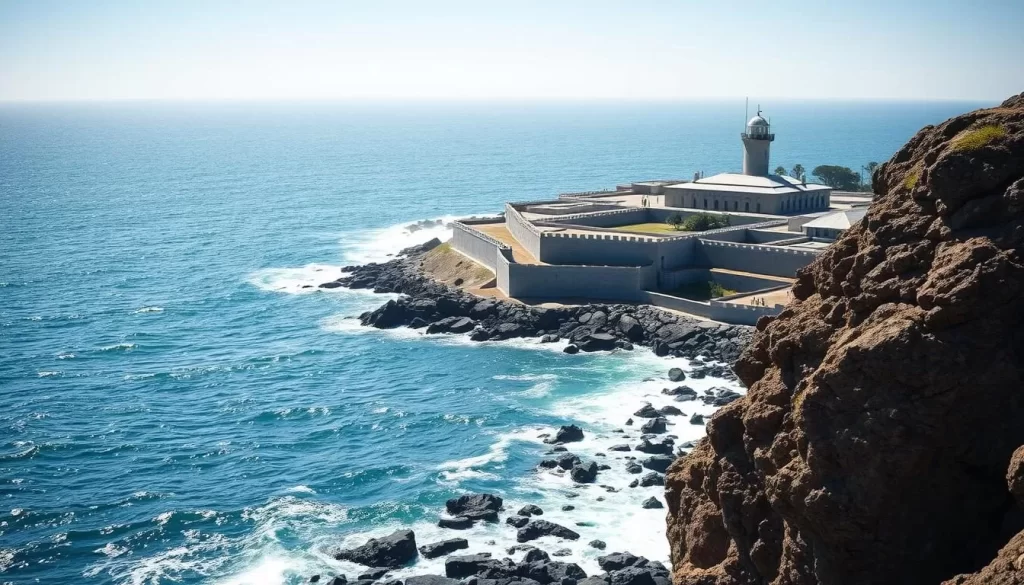
Visiting Nelson Mandela’s Cell
Visiting Nelson Mandela’s cell—a tiny space measuring just 8 feet by 7 feet where he spent 18 years—is a profound and humbling experience that helps visitors understand the sacrifices made in the struggle for freedom. You will have the opportunity to see the cell and reflect on the harsh conditions faced by Mandela and other prisoners.
The Limestone Quarry Where Prisoners Worked
The limestone quarry where prisoners, including Mandela, were forced to work under the harsh South African sun is another must-see site. The glare from the white limestone permanently damaged many prisoners’ eyesight, including Mandela’s. At the entrance to the quarry, you’ll notice a pile of stones—a memorial started when former prisoners returned to the island in 1995 and each placed a stone in remembrance of their time there.
| Attraction | Description | Significance |
|---|---|---|
| Maximum Security Prison | Prison where Nelson Mandela and other political prisoners were held | Understanding the harsh conditions faced by prisoners during apartheid |
| Nelson Mandela’s Cell | Tiny cell where Mandela spent 18 years | Reflecting on the sacrifices made in the struggle for freedom |
| Limestone Quarry | Site where prisoners worked under harsh conditions | Memorial to the prisoners who suffered and their resilience |
Throughout your tour, you’ll hear personal stories and anecdotes that reveal both the brutality of the prison system and the remarkable resilience and dignity maintained by those imprisoned there. Your visit to Robben Island will be a memorable experience, filled with the stories of struggle and resilience.
The Robben Island Tour Experience
The moment you arrive on Robben Island, you’re enveloped in a story of struggle, resilience, and ultimate triumph. The tour experience is designed to take you through the island’s significant historical sites, providing a comprehensive understanding of its complex past.
The Bus Tour Around the Island
Upon arrival, you’re directed to waiting buses that take you to various heritage sites around the island. On board, a knowledgeable local guide shares insights into the island’s 500-year history, making the experience accessible and engaging for all mobility levels. The bus tour provides shade from the sun and covers the island’s historically dense areas.
Meeting Former Political Prisoners
One of the most impactful aspects of the Robben Island tour is the opportunity to meet and hear from former political prisoners who now work as guides. They share their personal experiences of imprisonment during the apartheid era, bringing the history to life and creating an emotional connection with visitors.
Robert Sobukwe’s House
A significant stop on the tour is Robert Sobukwe’s house, where this influential anti-apartheid activist was kept in solitary confinement. The house, located over 100 meters from the Maximum Security Prison, highlights the government’s efforts to silence opposition. Sobukwe’s story is a powerful example of the apartheid regime’s tactics to suppress ideological influence.
| Tour Component | Description | Significance |
|---|---|---|
| Bus Tour | Guided tour around the island’s historical sites | Provides context and information about the island’s history |
| Meeting Former Prisoners | Personal accounts from ex-political prisoners | Creates an emotional connection and deepens understanding |
| Robert Sobukwe’s House | Visit to the house where Sobukwe was kept in solitary confinement | Illustrates the apartheid government’s efforts to suppress opposition |
Other Notable Sites on Robben Island
The island of Robben Island is not just a reminder of South Africa’s turbulent past but also a haven for wildlife and a testament to the country’s complex history. As you take the Robben Island tour, you’ll have the opportunity to explore several other significant sites that highlight the island’s diverse past and natural environment.
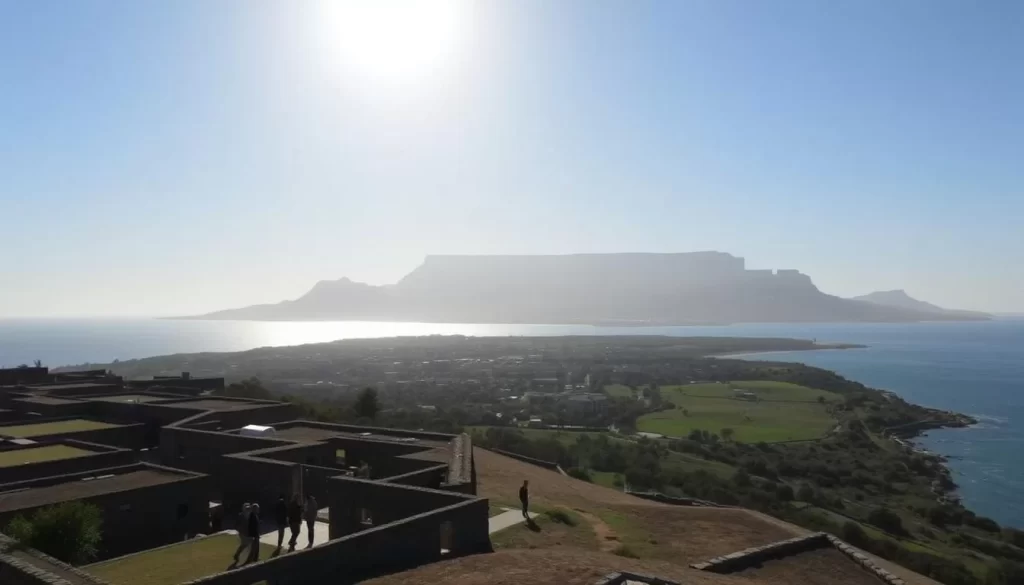
The Penguin Colony
One of the unexpected delights of visiting Robben Island is the chance to see the African penguin colony. These endangered birds have established a breeding colony on the island, adding a touch of natural beauty to the historical tour. Although you won’t get extremely close to them during the standard Robben Island tour, the penguins can often be spotted near the island’s coastline, providing a charming contrast to the somber historical sites.
World War II Fortifications
Robben Island’s history also includes its role as a strategic military base during World War II. The island’s isolated position made it valuable for defense purposes, leading to the construction of artillery batteries, bunkers, and an airstrip. These World War II fortifications stand as a reminder of this chapter in the island’s history, when it was used to protect Cape Town from potential naval attacks.
The Leper Graveyard
The leper graveyard is one of the most poignant sites on Robben Island, marking the final resting place for many people who were sent to the island when it served as a leper colony in the 19th century. This cemetery serves as a somber reminder of how the island was used to isolate society’s unwanted long before it became famous as a political prison, continuing its legacy as a place of banishment. As you visit this site, you are reminded of the island’s complex history and the many ways it has been used to separate people from mainland society.
These diverse historical elements, preserved by the Robben Island museum, help visitors understand that the island’s significance extends beyond its role in the anti-apartheid struggle, representing centuries of the country’s history.
Essential Tips for Visiting Robben Island
To make the most of your visit to Robben Island, it’s crucial to be well-prepared. The island offers a unique historical experience, but like any significant trip, planning is key to enjoying your time there.
What to Bring on Your Visit
When planning your visit to Robben Island, consider the activities you’ll be doing and the climate. You’ll need:
- Comfortable walking shoes, as the tour involves significant walking.
- Sun protection, including a hat, sunglasses, and sunscreen, to protect against the sun.
- A light jacket for the ferry ride, which can be chilly even on warm days.
- A bottle of water to stay hydrated throughout your trip.
Being prepared will enhance your experience and allow you to focus on the historical significance of the island.
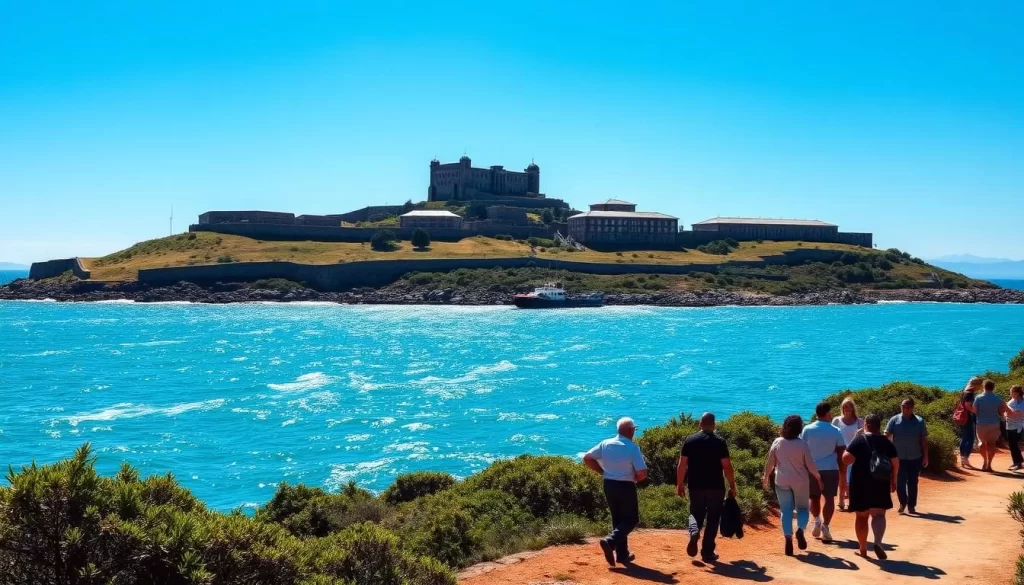
Photography Guidelines
During your Robben Island tour, you’ll have opportunities to take photos, including inside Nelson Mandela’s cell. However, it’s essential to be respectful, especially when your guide is speaking or in areas designated for reflection.
- Be mindful of your surroundings and other visitors.
- Avoid using flash or taking photos in a way that might disrupt the experience for others.
By being considerate, you can capture memories while respecting the site’s significance.
Accessibility Information
The Robben Island tour is designed to be accessible, but there are some considerations to keep in mind. The bus portion of the tour accommodates visitors with mobility issues, but some parts of the prison tour involve walking and stairs.
- If you have specific accessibility needs, it’s advisable to contact the tour operators in advance.
- This will help ensure that arrangements can be made to accommodate your needs.
By planning ahead, you can ensure that your visit is enjoyable and accessible.
Conclusion: Why Robben Island Is a Must-Visit Destination
Visiting Robben Island is an emotional and educational experience that provides insights into South Africa’s journey towards democracy. As you plan your trip to Cape Town, include Robben Island in your itinerary to understand the country’s turbulent past and its path to reconciliation.
The island offers a unique opportunity to learn from former political prisoners and understand the significance of this South African heritage site. With its rich history and stunning natural beauty, Robben Island is a must-visit destination that complements other iconic experiences in Cape Town, such as visiting Table Mountain and exploring the V&A Waterfront.
By visiting Robben Island, you not only enrich your travel experience but also support the preservation of this important historical site. Take your time to reflect on the lessons learned during your visit, and you’ll leave with a deeper understanding of South Africa’s history and its people’s resilience.
Make Robben Island a priority in your Cape Town itinerary, and you’ll have a truly unforgettable experience that will stay with you long after your trip.
The above is subject to change.
Check back often to TRAVEL.COM for the latest travel tips and deals.
